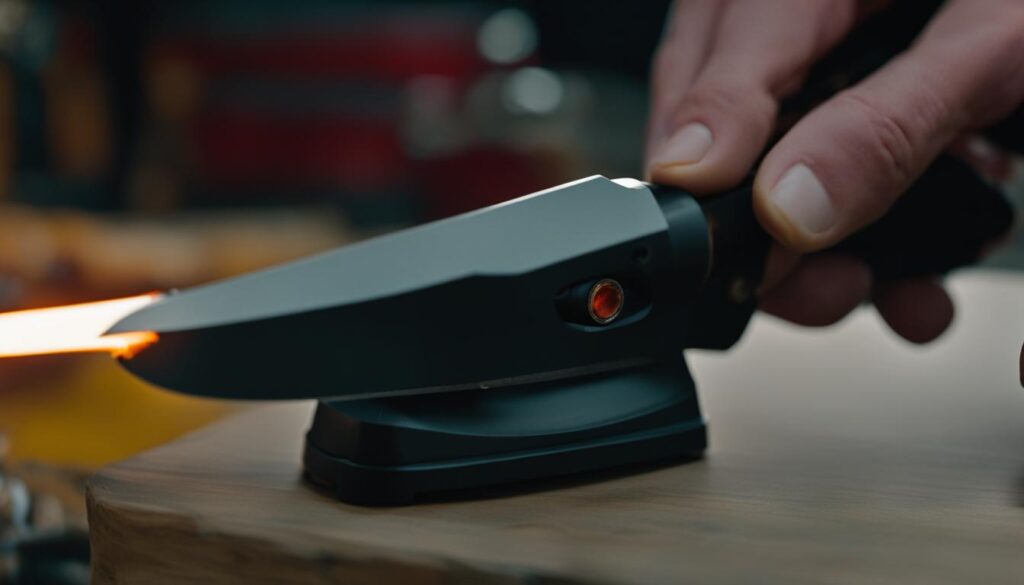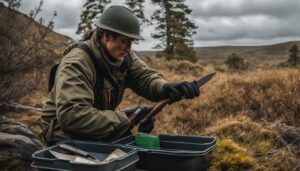A good hunting knife is an essential tool for outdoor enthusiasts, particularly for hunters. Whether you are tracking game or camping in the wilderness, a reliable hunting knife can make all the difference. But with great power comes great responsibility, and it’s important to prioritize safety when handling such a versatile and potentially dangerous tool.
In this comprehensive guide, I will walk you through the essential rules of hunting knife safety that every outdoor enthusiast should know. From choosing the right knife to mastering the art of sharpening, this guide will equip you with the knowledge and skills to ensure a safe and enjoyable hunting experience. Let’s dive in!
Key Takeaways:
- Choosing the right hunting knife involves considering factors such as game type and frequency of use.
- A blade length of about 4 inches or less is recommended for versatility and maneuverability.
- High carbon steel knives are preferred for their strength and performance.
- Specialty features like gut hooks or serrated edges can be useful depending on your hunting needs.
- Proper sharpening techniques, such as using whetstones or electric sharpeners, are essential for maintaining a sharp blade.
The Science of Knife Sharpening
Knife sharpening is a fascinating blend of art and science. Achieving optimal sharpness goes beyond simply honing the cutting edge; it involves understanding the underlying principles of sharpening and selecting the right tools for the job. Sharpness is not just about making a knife more efficient – it also enhances safety, ensuring a clean and controlled cut. So, let’s delve into the science behind knife sharpening and explore the key factors that contribute to razor-sharp edges.
The process of sharpening a knife involves eliminating imperfections on the blade’s cutting edge, such as burrs or jagged teeth. These imperfections can cause the blade to snag or produce uneven cuts. Different sharpening techniques, such as using whetstones or electric sharpeners, produce varying abrasion patterns on the blade, ultimately influencing the degree of sharpness achieved.
One critical factor in sharpening is the abrasive grit. Grit size determines the coarseness or fineness of the sharpening surface. Lower grit numbers, such as 4000, are considered coarse and are used for setting bevels or removing nicks on the blade. Higher grit numbers, like 8000, indicate a finer surface that is used for polishing the edge. Understanding the role of grit in sharpening helps in making informed decisions on the choice of abrasive material, whether it’s a whetstone or an electric sharpener.
In conclusion, knife sharpening is a science that combines knowledge of abrasion patterns, grit sizes, and the physics of sharpness. By understanding these principles, outdoor enthusiasts can select the appropriate sharpening method and achieve the desired level of sharpness for their hunting knives.
Knife Sharpeners Explained
When it comes to sharpening your hunting knife, there are various options to choose from. Knife sharpeners are essential tools that help restore and maintain the sharpness of your blade. In this section, we will explore the different types of knife sharpeners available on the market, including electric sharpeners and manual methods like whetstones and honing rods.
Electric Sharpeners
Electric sharpeners offer convenience and speed, making them a popular choice among outdoor enthusiasts. These sharpeners are equipped with motorized grinding wheels that do most of the work for you. They are designed to provide consistent results, ensuring that your knife always achieves a sharp edge. Additionally, many electric sharpeners come with built-in guides that help maintain the correct angle while sharpening.

Manual Sharpening
If you prefer more control and versatility, manual sharpening methods might be the right choice for you. Whetstones, also known as sharpening stones, are commonly used for manual sharpening. These stones come in various grits, allowing you to adjust the abrasiveness based on your specific sharpening needs. Manual sharpening requires practice and skill to achieve optimal results, but it offers the benefit of being able to sharpen knives of different lengths and shapes.
Choosing the Right Sharpener
The decision between electric sharpeners and manual methods ultimately boils down to personal preference and the desired level of precision. Electric sharpeners are great for quick touch-ups and heavily used knives, while manual sharpening provides more control and is ideal for those who enjoy the process of sharpening their knives by hand. Whichever type of sharpener you choose, it’s important to follow the manufacturer’s instructions and take proper safety precautions.
Overall, investing in a good knife sharpener is essential for maintaining the performance and longevity of your hunting knife. Whether you opt for an electric sharpener or prefer the hands-on approach with a whetstone, regularly sharpening your blade will ensure that it remains sharp and ready for your outdoor adventures.
Proficiency in Using Whetstones
Whetstone sharpening is a skill that every outdoor enthusiast should master to maintain a razor-sharp edge on their hunting knives. To achieve optimal results, it is crucial to understand the proper techniques and tools involved. Angle guides play a significant role in maintaining the correct angle while sharpening. By using angle guides, hunters can ensure consistency and accuracy in honing their blades. The recommended angle for sharpening hunting knives typically ranges from 15 to 20 degrees, depending on the desired sharpness and the knife’s edge geometry.
When choosing a whetstone, it is important to consider the abrasive grit. Grit size determines the coarseness or fineness of the stone and affects the sharpening process. Coarser grit stones, such as those with grit sizes around 4000, are ideal for setting bevels or removing nicks from the blade. Finer grit stones, ranging from 6000 to 8000, are used for polishing and refining the knife’s edge to achieve a finely honed finish. By selecting the appropriate grit size, hunters can achieve the desired level of sharpness for their specific needs.
Practicing and developing proficiency in using whetstones require patience and skill. It is important to start with a well-maintained blade and a clean whetstone. Consistent strokes along the entire length of the blade, using proper pressure and maintaining the correct angle, are key to achieving optimal results. Regular practice will enhance your sharpening technique and enable you to maintain a razor-sharp edge on your hunting knife, ensuring peak performance and durability in the field.


Summary:
- Whetstone sharpening requires proficiency in maintaining the correct angle while honing the blade.
- Angle guides play a crucial role in achieving consistency and accuracy in sharpening.
- Grit size determines the coarseness or fineness of the stone and affects the sharpening process.
- Coarser grit stones are used for setting bevels and removing nicks, while finer grit stones are used for polishing and refining the edge.
- Developing proficiency in using whetstones requires practice, patience, and proper technique.
The Debate Between Electric vs Manual Sharpeners
When it comes to sharpening your hunting knife, the debate between electric and manual sharpeners is a common one. Each option has its own advantages and disadvantages, so it’s important to understand the differences and choose the one that best suits your needs.
Electric sharpeners are known for their convenience and speed. These sharpeners use motorized wheels to quickly and efficiently sharpen your knife. They are especially useful for quick touch-ups or for knives that are heavily used. Many electric sharpeners also come with built-in guides that help maintain the correct sharpening angle, increasing the ease of use for beginners.
On the other hand, manual sharpening methods, such as whetstones or honing rods, provide more control and precision. With manual sharpeners, you have the freedom to adjust the sharpening angle based on the specific blade length or shape of your knife. This level of control allows you to achieve a custom edge that meets your specific needs. However, it requires a bit more practice and skill to master the art of manual sharpening.
The choice between electric and manual sharpeners ultimately depends on your personal preferences and the level of precision you desire. If you prioritize speed and ease of use, an electric sharpener may be the right choice for you. However, if you value control and the ability to customize your sharpening, manual methods may be the better option.
| Electric Sharpeners | Manual Sharpening |
|---|---|
| Convenient and fast | Offers more control and precision |
| Ideal for quick touch-ups | Allows for adjustments based on blade length and shape |
| Built-in guides for maintaining correct angle | Requires practice and skill |
Overall, both electric and manual sharpeners have their own strengths and weaknesses. Consider your specific needs and preferences to make an informed decision. Remember, regardless of the type of sharpener you choose, always prioritize treestand safety and use caution when handling sharp objects.
Conclusion
Prioritizing safety in deer hunting is essential for a secure and enjoyable experience. As an outdoor enthusiast, I understand the importance of following hunting laws and regulations to ensure the well-being of ourselves, others, and the environment. Familiarize yourself with local hunting laws and always comply with them.
Additionally, regular gear inspection and maintenance are crucial aspects of hunting knife safety. Before heading out, thoroughly check your hunting gear, including your knife, to ensure it is in proper working condition. Pay attention to the blade’s sharpness and handle’s grip. Any issues or defects should be addressed promptly.
When using a treestand, it’s imperative to prioritize treestand safety. Always inspect the treestand’s integrity and wear a proper safety harness. Furthermore, practice proper firearm safety and be aware of your surroundings at all times. Remember that safety is a shared responsibility, and by following these hunting knife safety rules, we can contribute to a safer hunting community.
FAQ
What factors should I consider when choosing a hunting knife?
Factors to consider include the game you’ll be hunting, how often you’ll be using the knife, the size of the knife, the handle grip, warmth, and durability, and the blade material and specialty features.
What type of blade length is recommended for a hunting knife?
Experts recommend a blade length of about 4 inches or less for a hunting knife.
What type of handle is best for a hunting knife?
The handle should provide good grip, warmth, and durability for optimal use in hunting situations.
What type of blade material is preferred for a hunting knife?
High carbon steel knives are preferred for their strength and performance.
What specialty features should I consider for a hunting knife?
Specialty features such as a gut hook, serrated edge, or saw blade can be useful depending on your hunting needs.
What should I look for in a knife sheath?
Choose a sheath that is lightweight, durable, and securely holds the knife.
Why is it important to have a sharp hunting knife?
A sharp blade is more efficient and safer to use, as it cuts cleanly without snagging.
How can I achieve sharpness in my hunting knife?
Sharpness is achieved by eliminating the jagged teeth or burrs on the blade’s cutting edge. Different sharpening techniques, such as using whetstones or electric sharpeners, can be used to achieve sharpness.
What are the different types of knife sharpeners available?
There are electric sharpeners and manual methods like whetstones or honing rods.
What are the benefits of using electric sharpeners?
Electric sharpeners offer convenience and speed, with motorized wheels doing most of the work. They often come with built-in guides for maintaining the correct angle.
What are the benefits of using manual sharpening methods?
Manual methods provide more control and versatility, allowing for adjustments based on specific blade lengths or shapes.
How do I sharpen a hunting knife using whetstones?
Proper use of whetstones involves maintaining the correct angle while sharpening and selecting the right abrasiveness or grit of the whetstone.
What is the debate between electric and manual sharpeners?
The debate revolves around convenience, control, and maintenance. Electric sharpeners offer speed and ease of use, while manual methods provide more control and precision.
How can I ensure safety while hunting?
It is important to familiarize yourself with hunting laws and regulations, inspect and maintain your hunting gear, and practice proper safety protocols. Always prioritize safety and be aware of your surroundings.





